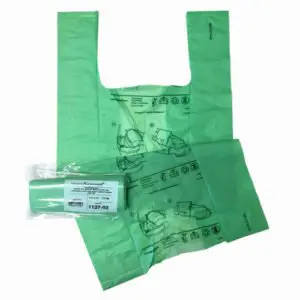Are composting toilets legal? I would answer a qualified yes.
However, if you are building a new home, the building inspector may insist on an “approved” composting toilet system. What exactly this means can vary from place to place. In some areas, composting toilets are welcome if properly installed and used. In other areas, authorities don’t seem to be thrilled with the idea, and may need some convincing. In my region, the inspector has told me “I understand what you are doing, and I like it. But there is nothing in the code book about it, so don’t ask and I won’t say no”.
In my experience, most people do not need a permit for installing a composting or waterless toilet. If you do need a permit, it’s best to talk to your local government. You might have to speak with a department manager, engineer, or someone in charge, as a special permit may be required. The building inspector is more likely to be helpful than the person behind the counter. If you have forward thinking people at your local government offices, you should be able to show them your waste management plan. If it is a sound plan, you may well get approval.
In urban areas especially, where new houses are concerned, authorities may require the basic infrastructure for a flush toilet to be built into the house ( drain pipe, vent stack and water supply). This is so future owners of the home will not be locked in to using a composting toilet.
In a way I can understand the concern. The municipality or county is handing over the very serious responsibility of dealing with human waste over to the home owner. They are concerned that a careless person might not deal with the output of their composting toilet appropriately, and someone could get sick, or water could be contaminated. When used properly, composting toilets produce harmless fertilizer only, but it does require care and attention.
Certifications for Composting Toilets
Some toilets have certifications from independent testing agencies. Typically this is an ETL certification (urine diverting toilets) or an NSF 41 certification (non-urine diverting toilets). In addition, there are many other certifying laboratories.
Older style “NSF 41 certified” composting toilet solid waste chamber. Yikes!There are places in North America where some kind of certification is required before they issue a permit for a composting toilet. However, these certifications are problematic. First, they do not address what happens to the solid material once it is removed from the toilet. Any composting toilet could quite possibly have fecal pathogens in the solid waste that you remove. It is critical that this waste is handled according to instructions, and that fecal contamination does not occur. The certifications provide no assurance of that.
The second problem is that some certifications are incredibly expensive to obtain. I’ve heard of fees in the range of $60,000 being charged, with annual ongoing fees of $7000-$9000 dollars per product or model. With no assurance that any government body will even accept the certification. For this reason, most manufacturers are deciding not to obtain certification. They see it as a money grab. They may have a point. Having discussed the “certification” process with one agency, I am very unconvinced that they know what they are talking about.
Complicating matters is the fact that some older toilets which do not work all that well have obtained certification, while some newer models that work much better do not have certification. So we have a crazy situation where toilets that don’t work very well are certified, and toilets that work very well are not certified.
The third problem is there is no universal agreement among government agencies on what certification to require. In my experience, a certification means little to most authorities, and is no guarantee your toilet will be approved.
So it’s difficult to answer the question – are composting toilets legal? It depends. .
New Guidelines on Composting Toilets
Thankfully, very detailed new guidelines on composting toilets have recently been published. This was a very carefully thought out process, written by an engineer and peer reviewed. These are probably the best, most comprehensive guidelines on composting toilets in North America today. Although published in Canada by the British Columbia Ministry of Health, I am hopeful they will be read and adopted widely by governments across North America. It might be an idea to obtain a copy, and take it to your local authorities when you try to convince them that your installation will be properly done, with no risk of problems. You can read the complete guidelines here: BC government guidelines on composting-toilets.
The Thinktank waterless toilet stores the waste for safe removal. When combined with a storage receptacle for the solid waste (such as a compost bin), it is capable of meeting these government guidelines.
This page attempts to answer the question: are composting toilets legal? Please share your experiences below to help others.
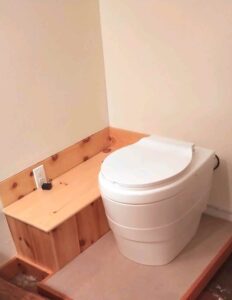





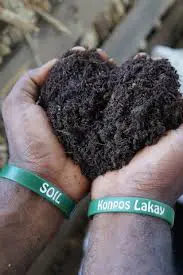




 You can download a wonderful guide to using urine as fertilizer from the
You can download a wonderful guide to using urine as fertilizer from the 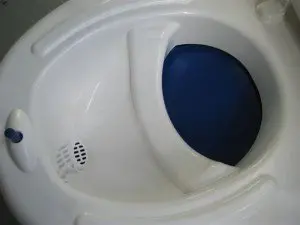
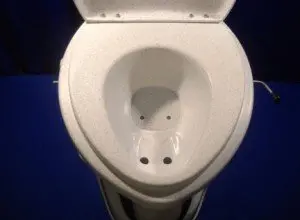
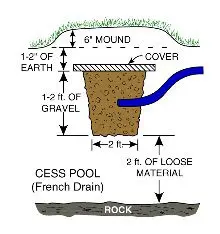



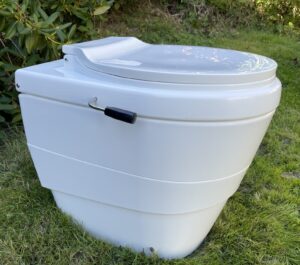
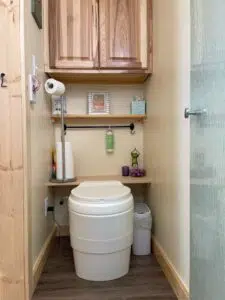
 It is critically important to properly locate the vent for your tiny house composting toilet. There is not a lot of odor coming out of the vent pipe – but there is some. The end of the vent pipe should not be within 8 feet of any area with foot traffic, a door, or an opening window. Sometimes you can just go straight out the wall and that location is fine. If not, you need to go through the wall, put a 90 degree elbow on the pipe, and run it up to the roof or above. There are other options, including going through the floor. But remember that air does not like to travel through a pipe, and the pipe must be as short and straight as possible. Consult with the person who sold you the toilet, or an HVAC specialist if in doubt.
It is critically important to properly locate the vent for your tiny house composting toilet. There is not a lot of odor coming out of the vent pipe – but there is some. The end of the vent pipe should not be within 8 feet of any area with foot traffic, a door, or an opening window. Sometimes you can just go straight out the wall and that location is fine. If not, you need to go through the wall, put a 90 degree elbow on the pipe, and run it up to the roof or above. There are other options, including going through the floor. But remember that air does not like to travel through a pipe, and the pipe must be as short and straight as possible. Consult with the person who sold you the toilet, or an HVAC specialist if in doubt.
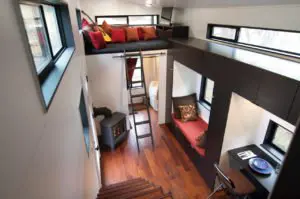 The tiny house movement has taken the nation by storm and is rapidly spreading to other countries around the globe as well. The genesis of tiny houses, as most of us picture them, came from the creative vision of a man named Jay Shafer. In the late 1990s Jay grew tired of spending winters in his Airstream which was not insulated and adapted for a midwest climate. Sparked by ideas he’d seen in some home-built RV books, he took it upon himself to design and build his own diminutive home on a trailer base. It suited his needs and saved him a ton of money over conventional housing.
The tiny house movement has taken the nation by storm and is rapidly spreading to other countries around the globe as well. The genesis of tiny houses, as most of us picture them, came from the creative vision of a man named Jay Shafer. In the late 1990s Jay grew tired of spending winters in his Airstream which was not insulated and adapted for a midwest climate. Sparked by ideas he’d seen in some home-built RV books, he took it upon himself to design and build his own diminutive home on a trailer base. It suited his needs and saved him a ton of money over conventional housing.




